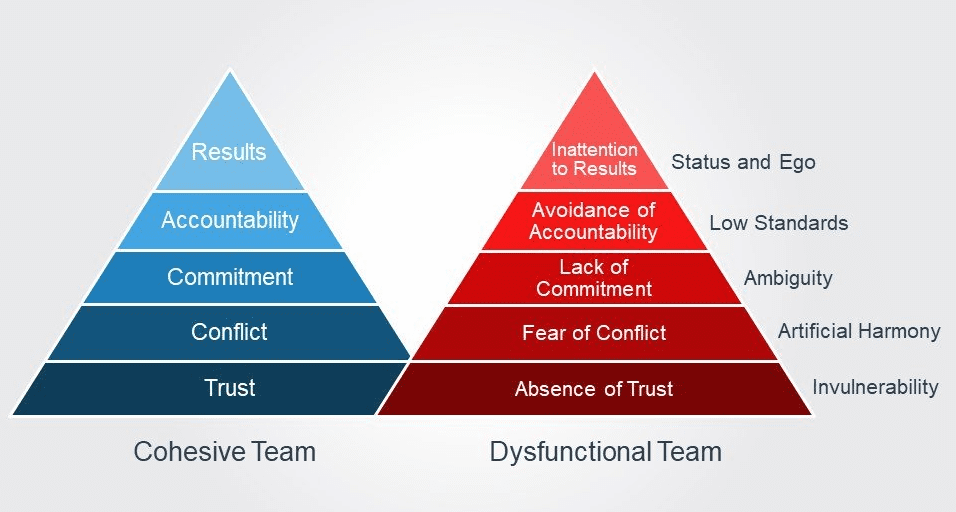A decade ago, the results-only or results-oriented work environment (ROWE) began making waves in HR departments. Its core principle is to judge people on results rather than hours worked. Results-oriented teamwork is a little different and somewhat more complex, but its goal is similar – to create a work environment that lets people excel instead of getting them bogged down in procedure, politics and activities that don’t advance the organization in any meaningful way.
Results-oriented teamwork was first propagated in a book from the American management consultant Patrick Lencioni in 2002 (so the idea predates ROWE). He contrasts a functional team with a dysfunctional team by means of two pyramids. Each layer in each pyramid is the foundation of the next building block.
Lencioni’s pyramid

Source: toolshero.com
Trust is the primary foundational value of any team. Teams where members trust one another can still fail, but teams where absence of trust is the foundation will sooner or later fail completely. In other words, a team where trust is absent isn’t a team.
The value of conflict may sound odd at first, but conflict can be a positive force if there is trust. If team members can communicate openly, they reinforce their basic trust and can step up to the next level – committing themselves without holding back. Clear communication and open agendas make it far easier to commit to than conflict avoidance and the resulting ambiguity.
The penultimate step of Lencioni’s pyramid is accountability. If the team members’ commitments are true and plain to see, it becomes much easier to hold each member accountable for achieving (or not achieving) their goals. It’s no coincidence that results are the final step. Attention to these results flows naturally from their four preceding steps.
A dynamic reality
Of course, this model is fairly static. In reality, a successful team may want to re-evaluate where it’s at on a frequent basis. Sometimes accountability doesn’t produce the desired results and the team will go back to discussing commitment.
Lencioni’s pyramid also needs to be supported by the team’s management. Managers have to have the right vision to see what phase of the pyramid their team members are at and where some people may need a nudge or further skill development (this includes looking at themselves).
For instance, some people are naturally more reserved to speak their minds, or you feel that during a budget meeting, someone is holding back a little. Individual coaching and team coaching can play a vital role here in helping employees reach the next level. Even top-performing teams will require time-out, team building or a step back from time to time.
Let’s apply the science
Lencioni’s pyramid is applicable to a variety of contexts, including sports teams, teams of volunteers as well as professionals. At Oxygen, we strongly believe in applying this model to get the best out of teams and organizations, but we recognize that this process is not always easy or fast. It’s one of the reasons why we are here for you – we don’t just talk the talk but we will also walk the walk, right along with you.
Curious? Say hello at info@oxygen.com or give us a call. We’d love to hear from you.

